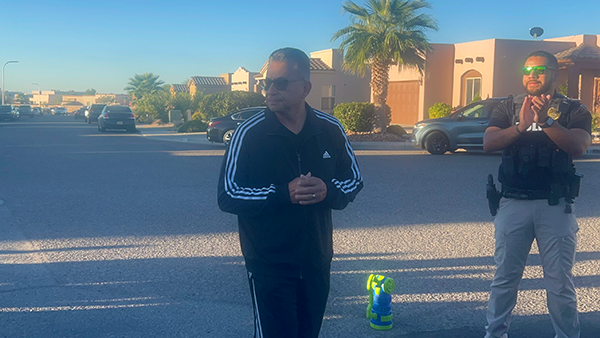
Las Cruces Public Schools observed “Walk to School Day” on September 18, 2024. Las Cruces Mayor Eric Enriquez, bubble maker in hand, joined Las Cruces Police Officers, Organ Mountain High School student athletes, cheerleaders, teachers, parents and mobs of students as they walked to school together in celebration of the annual event.

For nearly 30 years, National Walk to School Day has encouraged school-aged children to slip on their sneakers and make their way to school the old fashioned way–on foot. The idea for a national day to encourage walking to school sprang from a public/private alliance in the 1990s. That alliance no longer exists, but Walk to School Day continues. It goes to show that good ideas have legs that last long after those who planted the seeds of inspiration.

Where did this idea originally come from ?
National Walk to School Day was originally organized by the Partnership for a Walkable America. Walk to School Day in the USA began in 1997 as a one-day event aimed at building awareness for the need for walkable communities. The tradition continues, and is typically observed the first Wednesday in October–October 4, this year. Las Cruces Public Schools and the City of Las Cruces observed the event early because student will be out of school for Fall Intercession this October 4, 2024.
Today, Walk to School Day is promoted by Safe Routes to School.
Safe Routes To School
The National Center for Safe Routes to School is part of the UNC Highway Safety Research Center (HSRC), which in 2016 received funding from USDOT to lead the Collaborative Sciences Center for Road Safety, a National University Transportation Center. We work closely with the Pedestrian and Bicycle Information Center (PBIC), which is also part of HSRC and serves as the US Department of Transportation’s clearinghouse for pedestrian and bicycle research and tools.
The National Center was established in 2006 when HSRC was selected to serve as the Federal Highway Administration’s Safe Routes to School Clearinghouse. The National Center is applying what we have learned during our ten years of serving as the clearinghouse as we broaden our initiatives. This experience informs the thinking behind our framework for advancing the larger goals of Vision Zero.
“Our Vision Zero for Youth initiative was launched with support from the FIA Foundation and the US Department of Transportation. Our SRTS funders have included the Federal Highway Administration, the National Highway Traffic Safety Administration, General Motors, Schwinn, Clorox Greenworks, and the Robert Wood Johnson Foundation.” The Safe Routes to School National Course, developed by the Pedestrian and Bicycle Information Center and maintained by the National Center, was funded by the Centers for Disease Control and Prevention, the Environmental Protection Agency, Federal Highway Administration, and the National Highway Traffic Safety Administration.
What was Partnership for a Walkable America?
The Partnership for a Walkable America was an alliance of public and private organizations, and individuals who are committed to promoting the changes needed to make America more walkable. The organization, while working closely with the DOT Secretarial Initiative for Pedestrian and Bicycle Safety and other federal projects, functioned as an independent alliance. The Partnership represented safety, health, and recreation interests of all populations including senior citizens and children. Anyone interested in making America a better place for walking was invited to participate. This partnership was formed in the 1990s, but no longer functions, today.
Background
We have overlooked and undervalued walking for too long. Pedestrians are the invisible road users and walking is the forgotten transportation mode. These problems directly affect the number of pedestrian fatalities and injuries that occur each year. Our standard of living is reduced because the very design of many communities makes it difficult or dangerous for those who want to walk. Our nation is often not walkable.

Objectives
Improved Safety — Make walking in America safer by reducing motor-vehicle related deaths and injuries. To do this, the Partnership aims to create greater awareness of the safety problems faced by people who walk, and to increase citizen demand for solutions to these problems. For example, see
- Crossing Advice for Pedestrians
- For a Safe Path Through Work Zones — “Don’t Miss Your Cues”
- The Signs of Safety Are Everywhere
Increased Pedestrian Access — Create demand for greater and easier access to places for people who want to walk. Provide information about how to achieve walkable communities. The Partnership will help ensure that the needs and concerns of pedestrians are part of the decision making process that determines what communities are like.
Promote the Health Benefits of Walking — Encourage walking as one of the easiest ways for Americans to improve their health and lower health care costs. The benefits of walking, as a form of exercise, can be tremendous in terms of well-being and reduced health care costs.
Strategies
Identify safety, environmental, and policy changes that are needed to make America more walkable. Promote pedestrian safety and accessibility, and encourage walking as an important transportation option. Highlight situations and approaches that are particularly good or bad for walking. Educate the public and policy makers about the importance of a walkable community and how to achieve it.








![“Seven Nights of Lights and Luminarias” Among Most Read Articles in 2024 [#7]](https://lascrucesdigest.com/wp-content/uploads/2024/12/Luminarias-Old-Town-dm-1000x500_4F39B06A-5056-A36A-06831FDB1E06DF9C_4f3c202e-5056-a36a-0667e4166bf66da1.jpg)